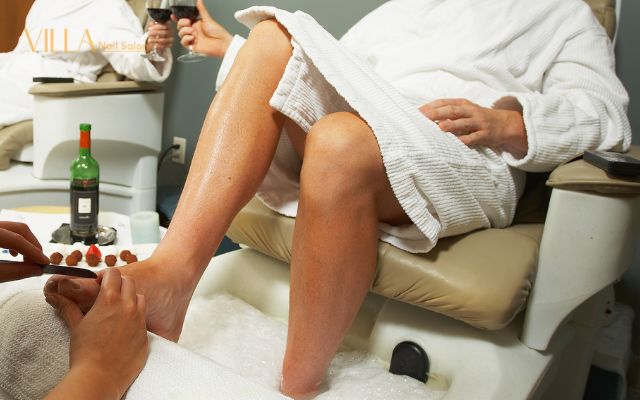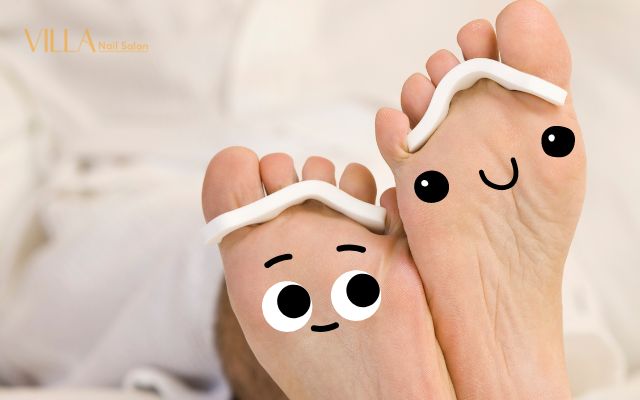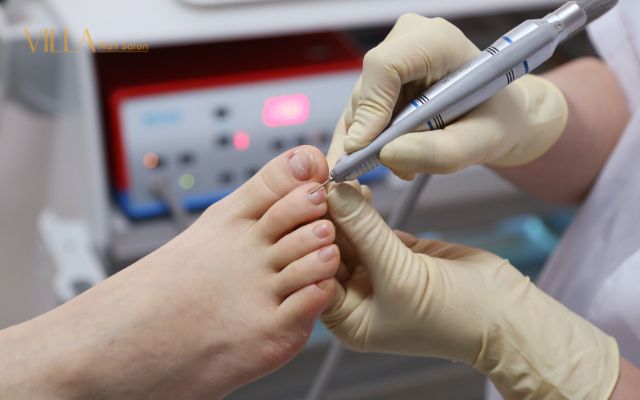How often should a man get a pedicure? The frequency of pedicures can vary depending on individual needs and circumstances. In this article, we will explore the factors that influence the recommended frequency of pedicures for men, providing valuable insights and guidelines to help you maintain healthy, well-groomed feet. Whether you’re a pedicure enthusiast or new to the idea, understanding the optimal frequency will ensure that your feet are in their best condition. So, let’s dive in and discover how often a man should get a pedicure for optimal foot care and maintenance.
Table of Contents
ToggleHow Often Should a Man Get a Pedicure?

When it comes to the frequency of pedicures, several factors come into play. Personal preferences, foot conditions, and lifestyle all influence how often you should schedule a pedicure. While there is no one-size-fits-all answer, a general guideline is to get a pedicure every 3 to 6 weeks. However, this timeframe may vary depending on individual needs and circumstances. It’s essential to listen to your body and make adjustments accordingly.
Factors Influencing Frequency
The frequency at which a man should get a pedicure can vary based on several factors. Understanding these factors will help you determine the ideal frequency for your foot care needs. Here are the key factors that can influence how often you should schedule a pedicure:
1. Personal preferences and comfort
Every individual has unique preferences when it comes to their feet. Some people may enjoy the relaxation and self-care aspect of pedicures, prompting them to schedule more frequent appointments. Others may prefer a less frequent schedule based on personal comfort or financial considerations. Consider your own preferences and how often you feel the need to pamper your feet.
2. Foot conditions or issues
Certain foot conditions or issues may require more frequent pedicures. If you have calluses, corns, or rough skin that builds up quickly, regular pedicures can help in managing these problems. Similarly, if you are prone to ingrown toenails or fungal infections, more frequent pedicures can aid in preventing these issues or addressing them promptly. Consulting with a podiatrist or a professional manicurist can provide valuable insights into how often you should address specific foot conditions.
3. Lifestyle and activities
The activities you engage in on a daily basis can also impact the frequency of pedicures. If you lead an active lifestyle that involves sports, exercise, or physically demanding work, your feet may experience more wear and tear. Regular pedicures can help alleviate the strain on your feet and provide necessary care to maintain foot health. Additionally, individuals who frequently wear closed-toe shoes for long hours may benefit from more frequent pedicures to prevent issues like foot odor or discomfort.
Signs It’s Time for a Pedicure

Knowing when it’s time to schedule a pedicure is essential to maintain foot health and appearance. Look out for these signs that indicate it’s time for some foot pampering:
1. Visible signs of overgrown nails or uneven edges
If your toenails start to grow too long, it’s a good indicator that a pedicure is needed to trim and shape them properly. Overgrown nails can lead to discomfort, ingrown toenails, or snagging on socks and shoes. Additionally, if you notice uneven edges or jagged nails, it’s a sign that your nails require professional attention to maintain their shape and prevent potential issues.
2. Build-up of calluses or rough skin
Calluses and rough skin can develop due to friction or pressure on your feet. Over time, they can become thick and unsightly, causing discomfort and affecting the overall appearance of your feet. Regular pedicures involve exfoliation and removal of dead skin, helping to eliminate calluses and smooth out rough areas. If you notice an accumulation of calluses or rough patches, it’s a clear indication that it’s time for a pedicure to address these concerns.
3. Discoloration, fungal infections, or other foot issues
Pay attention to any discoloration, signs of infection, or persistent foot problems. Discoloration can indicate underlying issues like fungal infections or circulation problems. If you notice any redness, swelling, itching, or other signs of infection, a pedicure can help address these concerns. The thorough cleaning, sanitization, and specialized treatments provided during a professional pedicure can aid in resolving or managing these foot issues.
General Recommendations for Men Pedicures

To keep your feet healthy and well-groomed, consider the following general recommendations for men’s pedicures:
- Frequency suggestions based on factors and personal needs: It’s recommended for men to get a pedicure every 4 to 6 weeks. Adjust the frequency based on personal preferences, foot conditions, and lifestyle.
- Consult with a professional: Seek advice from a professional manicurist or podiatrist to determine the ideal frequency and personalized care for your feet.
- Customized treatments and add-ons: Explore additional services such as foot massages, moisturizing treatments, or nail art to enhance your pedicure experience.
- At-home foot care routine: Establish a regular foot care routine, including daily cleansing, moisturizing, proper nail trimming, and weekly exfoliation.
DIY Men Foot Care Tips between Pedicures
Keep your feet looking and feeling their best between pedicure appointments with these quick and easy DIY foot care tips for men.
- Frequency suggestions based on factors and personal needs: It’s recommended for men to get a pedicure every 4 to 6 weeks. Adjust the frequency based on personal preferences, foot conditions, and lifestyle.
- Consult with a professional: Seek advice from a professional manicurist or podiatrist to determine the ideal frequency and personalized care for your feet.
- Customized treatments and add-ons: Explore additional services such as foot massages, moisturizing treatments, or nail art to enhance your pedicure experience.
- At-home foot care routine: Establish a regular foot care routine, including daily cleansing, moisturizing, proper nail trimming, and weekly exfoliation.
Common Concerns about Pedicures

Pedicures are a wonderful way to pamper your feet and keep them looking their best. However, it’s natural to have some concerns when it comes to undergoing a pedicure. Let’s address a few common concerns and provide reassurance:
1. Hygiene and cleanliness at nail salons
One common concern is the cleanliness and hygiene of nail salons. It’s important to choose a reputable salon that prioritizes cleanliness and follows proper sanitization protocols. Look for salons that use sterilized tools, have a clean working environment, and employ nail technicians who adhere to strict hygiene practices. Don’t hesitate to ask about their sanitation procedures to ensure a safe and clean experience.
2. Safety measures for preventing infections or injuries
Another concern revolves around the safety measures taken during a pedicure to prevent infections or injuries. Reputable salons prioritize the well-being of their clients. They use disposable tools or properly sterilize reusable tools to maintain a sanitary environment. Nail technicians should follow strict hygiene protocols, such as washing their hands, wearing gloves, and using clean towels or liners for each client. Additionally, they should be cautious and gentle when performing nail trimming or cuticle care to minimize the risk of injuries.
3. Communication with pedicurists regarding preferences and concerns
It’s common to worry about effectively communicating your preferences and concerns to the pedicurist. Remember that open communication is key to a satisfying pedicure experience. Don’t hesitate to discuss your preferences, such as nail shape or desired polish color. If you have specific foot concerns or sensitivities, inform the pedicurist beforehand. They are there to assist you and provide personalized care based on your needs. A skilled pedicurist will listen attentively and address any concerns you may have.
What Happens If You Don’t Get Regular Pedicures?
Regular pedicures offer more than just a luxurious treat for your feet. They play a vital role in maintaining foot health and overall well-being. If you neglect regular pedicures, several consequences can arise:
1. Accumulation of calluses and rough skin
Without regular exfoliation and removal of dead skin, calluses and rough patches can build up on your feet. These can become thick and uncomfortable, causing discomfort and potentially leading to painful cracks or fissures in the skin.
2. Ingrown toenails and infections
Neglected toenails that become overgrown or improperly trimmed are prone to developing ingrown toenails. Ingrown toenails occur when the edge of the nail grows into the surrounding skin, causing pain, swelling, and potential infections. Infected ingrown toenails can lead to further complications if left untreated.
3. Fungal or bacterial infections
Lack of regular foot hygiene and neglecting pedicures can increase the risk of developing fungal or bacterial infections. Warm, moist environments, such as inside closed-toe shoes, provide a breeding ground for these infections. Common conditions include athlete’s foot (fungal infection) or bacterial infections. These infections can cause itching, redness, discomfort, and may require medical treatment to resolve.
4. Foot odor and discomfort
Neglected feet can develop unpleasant odors due to bacterial growth and the accumulation of sweat and dead skin. Without regular cleansing and care, foot odor can become a persistent issue. In addition, neglecting foot care can lead to discomfort, such as soreness, dryness, and fatigue, especially if you spend long hours on your feet.
5. Impact on foot appearance and self-confidence
Neglected feet can appear rough, unattractive, and lacking proper grooming. This can affect your self-confidence, particularly when wearing open-toe shoes or going barefoot. Regular pedicures help maintain attractive and well-groomed feet, boosting your self-esteem and overall sense of well-being.
Conclusion
In conclusion, regular pedicures are essential for maintaining the health and appearance of your feet as a man. By following the recommended guidelines and adjusting the frequency based on personal needs, you can enjoy the benefits of healthy and attractive feet. For more foot care tips and expert advice, visit the Villa Nail Salon blog and discover how you can keep your feet in top condition. Don’t neglect your foot health—prioritize regular pedicures and give your feet the care they deserve.

